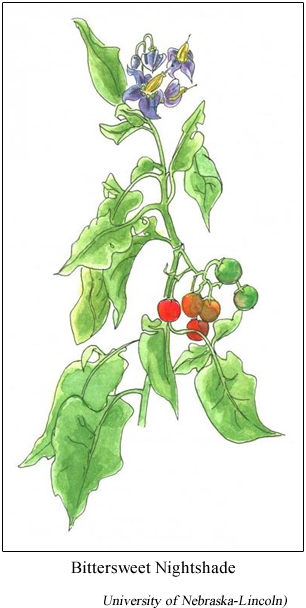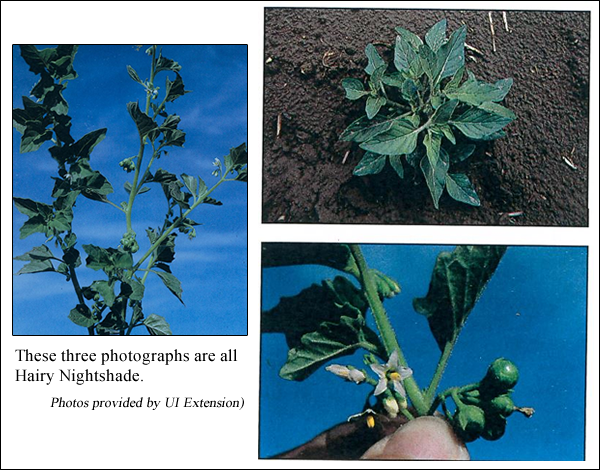Nightshade weeds can be dangerous to people and
animals
Four cattle thought
to have died after eating the plants |
|
September 20, 2018 |
Some Boundary County livestock have died, and at
least one pet made sick, apparently because of a
plant that is found somewhat commonly throughout
the northwest, including here in our area.
Reports have been received that a plant from the
Nightshade family is likely responsible for the
recent deaths of four head of cattle, owned by a
Three Mile area family. The cattle would have
been poisoned from eating this particular plant.
Yesterday, a pet owner found his puppy to be
sick, after having chewed on a plant found
outside around the home. The puppy ended up at
the veterinarian's office, and the plant was
taken to the Extension Office, where it was
identified as Bittersweet Nightshade.
Nightshade is not a plant that has suddenly
arrived in Boundary County, it has been around
for a long time. However, staff at the Extension
Office feel it is important make local residents
aware of the plant, and its potential dangers to
livestock, pets, and sometimes to people.
Nightshade is the common name for the plant
family known officially as Solanaceae. Although
species of this plant family can be harmful,
some may find it curious that other plants of
the same family are important as agricultural
crops and commonly used in the human diet, the
list including potatoes, tomatoes, eggplant,
bell peppers, chilis, tomatillos, and others—all
are members of the Nightshade family.
Further, some Nightshade plants have important
medicinal purposes, providing the original
sources for the medicines scopolamine, atropine,
hyoscyamine, and others. Still other Nightshade
plants are cultivated as ornamental trees and
shrubs. Petunias, for example, are in the
Nightshade family. "Bittersweet nightshade
is a former ornamental that was planted
throughout Idaho in what today we consider old
homesteads," said Timothy Prather, an Invasie
Plant Biologist at the University of Idaho.
The Nightshade plants that are considered more
hazardous, such as Hairy
Nightshade and Bittersweet Nightshade (also
known as Bitter Nightshade), contain dangerous
levels of alkaloids, some of which can be toxic
to animals, in some cases even at low doses. As
far as humans go, some alkaloids can be safe,
but others can be toxic. Over centuries past,
some Nightshade plants have been used as
poisons.
Dr. Prather from the University of Idaho agrees
that even people should be cautious with
Nightshades. "Each of the Nightshades can
be a problem," he said. "People associate
red color with danger and purple color with
edible. However, that is not even close to
reliable. Children in particular are attracted
to the dark purple-colored berries. Hairy and
Black Nightshade both can be weeds within crops,
and typically they are problems in cropfields of
other plants within their same family.
Nightshades are in the same plant family with
tomatoes and potatoes."
Story continues below these pictures:
(

Nightshades are found on all continents of the
world, excepting Antarctica, and are present
throughout the Pacific Northwest, including here
in Boundary County. All in all, there are
approximately 2,700 different species of the
Nightshade family.
Nightshades can cause aggravating weed problems,
and as mentioned they are commonly found in the
Northwest. The Nightshade found most commonly in
the Northwest is the annual Hairy Nightshade,
which often invades disturbed land. Other annual
Nightshades of the Northwest include the Black
Nightshade and Cutleaf Nightshade. The
Bittersweet Nightshade is a perennial that can
be a problem in perennial crops, also in lands
that are non croplands. Both the berries and the
foliage of the more toxic Nightshade plants are
known to be potentially dangerous.
Sometimes Nightshade will grow with hay or other
silage; very small contaminations of Nightshade
in those crops may well be safe. However, hay
that is heavily contaminated with Nightshade
should not be fed to livestock.
"Nightshades can be problems for livestock,"
said Dr. Prather from the University of Idaho.
"Nightshades are not palatable to livestock in
general, and so poisoning may occur when
nightshades are harvested with hay."
Fortunately, Dr. Prather says that "Livestock
generally do not eat sufficient amounts when
grazing to cause illness."
Boundary County Weed Superintendent Dave Wenk
points out that, although they can definitely
cause problems, Nightshade is not listed as a
noxious weed, nor is it considered invasive. "It
is not on the noxious weed list and it is not
necessarily invasive, but we seem to be having
an abundance of it this year. Just like we had
an abundance of flea beetles last year," he
said. Since it is not listed as a noxious weed,
there is no county program to control
Nightshade.
To help landowners recognize and identify two of
the more common Nightshade in Boundary County,
we are including a couple of illustrations. Mr.
Wenk points out that one might spot Nightshade
because "The plants look very much like tomatoes
and / or potatoes, as they are all in the
Nightshade family."
What should landowners and homeowners do if they
discover they have Nightshade on their property?
"Educate themselves on what the plants look
like, and remove them from their property by any
means," said Mr. Wenk. "Some of the Nightshades
are annuals, so they can be weed whacked and
they won’t come back. The two plants that came
into this office [for identification] are
perennials, and need to be removed. Digging
might work, making sure to get all of the roots,
or by chemical control as weed whacking will
only knock perennials back now—they will return
next year."
|
|
Questions or comments about this
article?
Click here to e-mail! |
|
|
|
|

